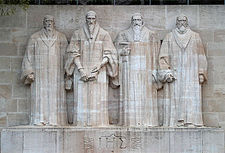| Part of a series on |
| Reformed Christianity |
|---|
 |
|
|
New England theology (or Edwardsianism) is a school of theology which grew up among the Congregationalists of New England, originating in the year 1732, when Jonathan Edwards began his constructive theological work, culminating a little before the American Civil War, declining afterwards, and rapidly disappearing after the year 1880.[1]
During this period it became the dominant school among Congregationalists, and led to division among Presbyterians into two strains: the New School Presbyterians (who leaned towards New England teachings) and the Old School Presbyterians (who repudiated dilution of the Westminster Standards). This theology was the basis of all the seminaries of the Congregationalists and several of the Presbyterians, and furnished the impetus for social change which birthed the American Board of Commissioners for Foreign Missions, established a series of colleges from Amherst in the East to Pacific University in the West, and led in a great variety of practical efforts to extend the Christian religion.[1]
It can be described as the Calvinism of the Westminster Confession and the Synod of Dort, modified by a conception of God taken by its advocates to be more ethical; by a new emphasis upon the liberty, ability, and responsibility of man; by the restriction of moral quality to action in distinction from nature (cf. original sin and total depravity); and by the theory that the constitutive principle of virtue is benevolence.[1] The New England theology went through several stages, including the New Divinity espoused by Samuel Hopkins and the New Haven theology espoused by Nathaniel W. Taylor.
- ^ a b c Jackson 1910.
